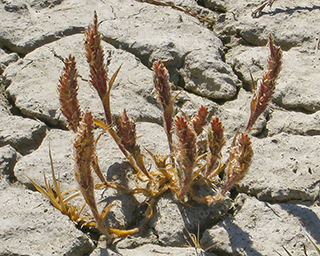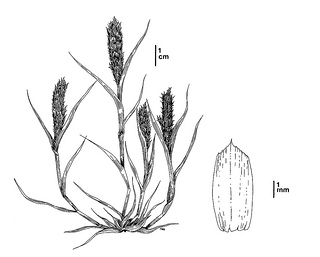(Tuctoria mucronata)
 Tuctoria mucronata. CDFW photo by Cherilyn Burton.
Tuctoria mucronata. CDFW photo by Cherilyn Burton.
 Tuctoria mucronata. CDFW illustration by Mary Ann Showers. (Click to enlarge)
Tuctoria mucronata. CDFW illustration by Mary Ann Showers. (Click to enlarge)
Solano grass, also known as Crampton’s tuctoria, is a California endangered plant species, which means that killing or possessing this plant is prohibited by the California Endangered Species Act (CESA). This species is also listed as endangered under the federal Endangered Species Act. Solano grass is an annual grass species that typically flowers in June. It only occurs in northern claypan type vernal pools within annual grasslands. This sticky, aromatic grass produces a dense spike of overlapping flower spikelets that emerge from the upper leaves, and grows to 12 cm (4.7 inches). Solano grass is only known from three occurrences: Olcott Lake in Solano County (likely the type locality); a nearby location in Solano County on private property; and at the Davis Global Communications site in Yolo County. No plants have been observed at Olcott Lake since 1993 despite extensive annual surveys, and this population is presumed to be extirpated. The cause of decline at this location is unknown. Possible causes are overcollection, changes in hydrology, displacement by other species, or a combination of these or other factors. The other Solano County population is small but persists. The Yolo County population is much larger, and is also persistent, but is threatened by invasion of non-native plant species, particularly perennial pepperweed (Lepidium latifolium).
Factors that may have contributed to the decline of this species include overcollection, changes in hydrology, and habitat degradation caused by discing, excavation, herbicide runoff, and industrial contaminants in the groundwater. Habitat modification, destruction, and degradation, and the resulting habitat fragmentation persist as primary threats to Solano grass. Other major threats to this species include contaminant runoff into vernal pools, drought, and climate change. Populations of Solano grass are also threatened by their small size and isolation, which may influence pollination success and increase vulnerability to extinction.
The U.S. Fish and Wildlife Service released a Recovery Plan for Vernal Pool Ecosystems of California and Southern Oregon in 2005, which includes Solano grass. Habitat protection and management is a key element in the recovery of Solano grass as well as other vernal pool endemic species. Efforts should be undertaken to reintroduce Solano grass into Olcott Lake and introduce this species into other suitable vernal pools in the vicinity of Jepson Prairie. The possibility of placing the unprotected Solano grass occurrence on private land under a conservation easement should be explored. Continued research should be funded that assesses pollination ecology for this species, pollination barriers, long-term trends in population growth, and the probabilities of local extinction and recolonization. A standardized formal monitoring program should be developed and implemented to collect data in sufficient detail to evaluate species status and examine changes in population dynamics and community composition. Management should include developing indicators for identifying potential problems and assessing ecosystem health, establishing requirements for appropriate management of vernal pool landscapes, and establishing improved guidelines, monitoring protocols, and success criteria for appropriate management of the species.
CDFW may issue permits for Solano grass pursuant to CESA, and you can learn more about the California laws protecting Solano grass and other California native plants. Populations of Solano grass occur in CDFW's Bay Delta Region. More information is also available from the United States Fish and Wildlife Service Species Profile for Solano grass.
Updated 3/19/2013